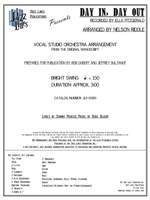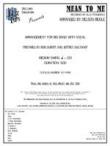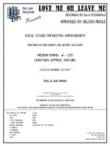DAY IN, DAY OUT
Recorded by Ella Fitzgerald
Arranged by Nelson Riddle, Prepared by Rob DuBoff and Jeffrey Sultanof

Cat #: JLP-9589
$75.00This item usually ships within 1 business day.
Questions?
Please call +1-518-587-1102 or email us.
Edition: Jazz Studio Orchestra Arrangement
Description: Swing - Medium Difficult
Publisher: Jazz Lines Publications
In 1964 Ella Fitzgerald went back into the studio to further her songbook series by recording songs written by Johnny Mercer. Supported by Nelson Riddle's arrangements, this session featured a slightly different ensemble: this time the big band was augmented by 2 flutes, oboe, 2 clarinets, 2 bassoons, and 3 horns in F. The story goes that Norman Granz was concerned about the budget and refused to hire string players. Thus, Riddle saved some money and hired some additional woodwind players and probably relied on overdubs to complete the mix. This publication is presented as-written by Riddle but also included are optional string parts that may be used in place of - or in addition to - the woodwind and French horn parts. And, an optional synthesizer part is also included that may be used in place of the string parts. So, this arrangement may be played by a standard big band with a synthesizer player. This publication has been prepared from the original set of parts used during the recording session - this is not a transcription. The vocal key is Eb throughout.
The arrangement begins with some simple rhythmic riffs in the saxophones and brass underpinned by some light but warm held tones in the woodwinds (or strings). The overall feel of this section should be extremely light and easy, with an overall bounciness in the rhythm section. This feel is largely maintaned throughout the entire arrangement, starting with the vocalist's entrance at the pick up to measure 9. The backgrounds continue to consist of held tones in the woodwinds and simple rhythmic hits in the brass and saxophones, but the volume level should be reduced a bit to allow the vocalist to stand out. Some occasional brief solo tenor saxophone interjections allow for a little bit of instrumental excitement.
The overall intensity of the arrangement should start to slowly but gradually pick up beginning at measure 41, where the rhythmic riffs in the saxophones and brass begin to increase in complexity and volume. This gradual build ultimately reaches its climax at measure 65, where the vocalist drops out for a moment to allow for a fairly simple but very exciting and high energy shout section from the ensemble. This ensemble section has some call and response elements between the saxophones and brass and the woodwinds/strings and horns; these different elements should be brought out in order to play off of one another and increase their effectiveness.
The vocalist re-enters with a pickup to measure 73, where the overall volume and complexity of the arrangement begins to gradually taper back down. The final few measures of the arrangement feature a brief improvised call and response between tenor saxophone and muted trumpet; the two soloists should listen to one another and work to achieve a level of musical continuity between each other. The arrangement comes to a subtle but appropriate conclusion with a soft but warm chord in the woodwinds/strings with a tenor sax cadenza on top.
Vocal
2 Flutes
Oboe
2 Clarinets
2 Bassoons
2 Alto Saxophones
2 Tenor Saxophones
Baritone Saxophone
4 Trumpets
3 Horns in F
3 Trombones
Bass Trombone
Harp
3 Violins (Alternate Parts for Woodwinds)
Viola (Alternate Part for Woodwinds)
Cello (Alternate Part for Woodwinds)
Guitar
Piano
Bass
Percussion: Vibraphone, Bells, Timpani, Xylophone
Drums
Synthesizer (Alternate Part for Strings/Woodwinds)
Trumpet 1: D6
Trombone 1: C5










